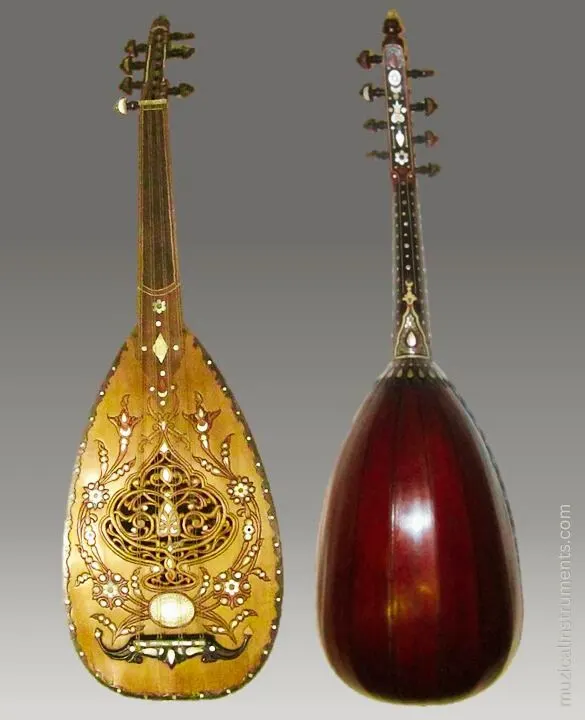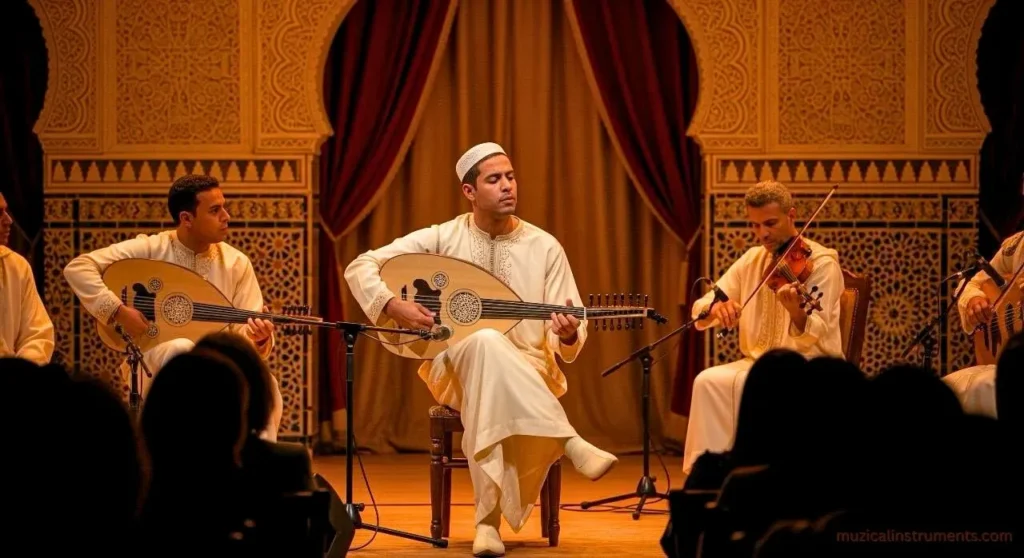Kwitra: The Small Algerian Guitar That Sings From the Soul
Kwitra is a small guitar from Algeria. Some call it Kouitra. Others say Quitra or Quwaytara. But no matter the name, it carries the same voice.
This voice is soft. Deep. Old. It comes from the days when Andalusian people had to leave Spain. They brought their music with them. That music found a home in Algiers, Tlemcen, and other parts of Algeria.
The Kwitra was part of that journey.
It’s not like your regular guitar. It’s smaller. It has a short neck. It has eight strings, in four pairs. It sounds warm and sweet. Not loud. Not sharp. Just calm.
People say it feels close to the oud, or even the mandolin. It belongs to the same family plucked lutes. But when you play the Kwitra, you’ll know. It has its own soul.
This isn’t just an instrument. It’s a bridge. From old stories to your hands. From Algeria to your ears.
And now, it’s time for you to hear it.
Kwitra at a Glance (Fast Facts)
Here is the basic, simple and clear idea about the Kwitra.
| Feature | Details |
|---|---|
| Name | Kwitra (also spelled Kouitra, Quitra) |
| Origin | Algeria (roots in Andalusian Spain) |
| Instrument Type | Plucked lute (composite chordophone) |
| Strings | 8 strings, arranged in 4 pairs (courses) |
| Tuning | G3–G3, E4–E4, A3–A3, D4–D4 |
| Size | Small body, short neck |
| Sound | Warm, soft, deep, emotional |
| Related To | Oud, mandolin, chitarra Italiana |
| Common Use | Classical, folk, Andalusian music |
| Special Features | Tree of Life soundhole, pearl inlays |
| Where to Hear | YouTube, museums, Algerian performances |
| How to Learn | Online videos, teachers, luthiers |
What Is the Kwitra?

The Kwitra is a stringed instrument from Algeria. It’s small. It’s light. You hold it close like a guitar.
Some people call it Kouitra, Quitra, or even Quwaytara. In Arabic, it’s called الكوترة (al-kwitra). Long ago, people in Andalusia called it the Andalusian oud.
You play it by plucking the strings. That makes it part of the lute family. More exactly, it’s a plucked lute. Experts also call it a composite chordophone. Don’t let that big word scare you. It just means the body and neck are joined as one.
The Kwitra is like the Oud, Mandolin, and Chitarra Italiana. They’re all cousins. But the Kwitra sounds gentler. Softer. Some say it sings.
It’s more than just music. It’s a memory. A story passed down from hand to hand.
Where the Kwitra Comes From
The Kwitra didn’t start in Algeria. It came from far away. Long ago, in the 1400s, people were forced to leave Spain. They were Muslims and Jews from Andalusia.
They had to leave their homes. But they didn’t leave their music.
They brought it to North Africa. They arrived at Algeria. They established Tlemcen and Algiers as their new cities. And they introduced with them a new sound, the Kwitra sound.
It was like the oud then. But years passed. It developed. It became smaller. It developed new forms. It evolved into something distinct.
Nowadays, when you hear the Kwitra, you hear that long way. From Andalusian Spain to Algerian streets. From pain to beauty. From the past to your hands.
How the Kwitra Looks and Feels
The Kwitra looks small, but it holds a big story. You can carry it easy. You can hold it close. It feels light in your arms.
It has a short neck. That makes it easier to reach the strings. You’ll see 8 strings, but they come in 4 pairs. Each pair is called a course. You play two strings at the same time.
The tuning is soft and sweet. Most players use this:
G3–G3, E4–E4, A3–A3, and D4–D4.

The body is made of fine wood. Some Kwitras have a shiny look, made with mother-of-pearl inlays. These tiny pieces shine like light on water.
There’s also a soundhole. Some are shaped like a vase. Some show a Tree of Life. This is not just art. It tells a story. A symbol of life, roots, and growth.
Near the strings, you’ll spot a small shield. That’s the pickguard. It keeps the wood safe from your hand or pick.
Everything on the Kwitra has meaning. The shape. The size. The sound. Even the shine. It’s not just made to play. It’s made to be loved.
What Makes the Kwitra Sound So Different
The Kwitra doesn’t shout. It sings. Soft. Warm. Deep. Like a voice telling you a secret.
When you play it, the sound is smooth. It’s not sharp like a modern guitar. It’s round. It’s full. You feel it more than you hear it.
That’s because of its shape and strings. The wood body gives it a warm tone. The paired strings make the sound richer. The short neck keeps the notes close and calm.
People say it sounds close to the oud. But the Kwitra is lighter. Some say it’s like the mandolin, but slower. Gentler. Sweeter.
You can play fast tunes. But most people use it for slow songs. Classical. Folk. Andalusian music. Songs with feeling. Songs that last.
If your music needs heart, the Kwitra gives it.
Can You Hear the Kwitra Today?
Yes, you can.
You don’t need to travel to Algeria. You don’t need to go back in time. The Kwitra is still here.
You can hear it online. Go to YouTube. Search for “Kwitra music.” Click play. Close your eyes. That’s not just sound. That’s a story.

Some Kwitras live in museums, too. One sits in the Metropolitan Museum. It’s old. It’s beautiful. It’s from the 1800s and comes from Morocco. It has pearl pieces and a sound hole shaped like a tree. A Tree of Life.
Other Kwitras are in the MIMO collection. That’s a big group of music museums from all over the world. They keep these instruments safe.
But the best place to find the Kwitra? In someone’s hands. On a quiet night. In a song you’ve never heard before.
And maybe, just maybe in your hands one day, too.
Can You Learn the Kwitra?
Yes, you can learn the Kwitra.
You don’t need to be an expert. You don’t even need to read music. You just need to listen. Feel. And try.
Start simple. Watch videos online. Search “How to play Kwitra.” You’ll see real people playing real songs. Try to copy what they do.
Some music schools in Algeria teach the Kwitra. Ask if they give lessons online. You might find a teacher who can help you from anywhere in the world.
Some people even build their own. These builders are called luthiers. They make Kwitras by hand. Some new ones look just like the old ones, with pearl, wood, and the tree-shaped sound hole.
Want one? You can buy a Kwitra online. Some shops sell them, or you can ask a luthier to make one for you.
You don’t need to be born in Algeria to play the Kwitra. You just need to feel the music.
It’s waiting for you.
Why the Kwitra Still Matters
Some instruments play music.
The Kwitra tells a story.

It’s been held by people who had to leave everything behind, except their songs. They carried the Kwitra from old Andalusian cities to new homes in Algeria. It was more than an instrument. It was comfort. A piece of where they came from.
And even now, after all these years, people still play it. Not for fame. Not for crowds. But because the sound means something.
When you hear the Kwitra, you don’t just listen. You feel it.
Like someone whispering a memory you forgot you needed.
That’s why it matters. It keeps stories alive. It brings people closer. It reminds you that even the quietest sounds can hold the biggest truths.
If you ever play it, even just once, you’ll understand.
Final Thoughts: You Don’t Just Hear the Kwitra. You Feel It.
The Kwitra is one of those instruments that doesn’t need to be loud to leave a mark.
It’s quiet. It’s honest. It speaks in a way that feels… familiar, even if you’ve never heard it before.
Maybe that’s why it still matters. Because in a world full of fast songs and noisy crowds, the Kwitra reminds us to slow down. To listen. To feel.
It carries stories from people who lost their homes but kept their music. It holds memories in every note, even the soft ones.
If you ever hold one, you’ll get it. It’s not just about learning to play. It’s about being part of something older, something that still breathes.
So maybe this isn’t just the end of an article.
Maybe it’s the start of something new, for you.
If you’re interested in folk instruments from around the world, Kazakhstan’s traditional dombra string instrument offers a bright, rhythmic voice with deep roots.
FAQ
1. What’s the difference between the Kwitra and oud?
The Kwitra is like a smaller cousin of the oud. It has 8 strings in 4 courses, a short neck, and a lighter, softer sound. It’s less booming, more gentle ear-hug.
2. Is it hard to build your own Kwitra?
Some people build them at home. On Reddit, a builder shared:
Others experiment with hobby tools, dyes, even 3D-printed parts but the result plays well and looks beautiful. A luthier’s path, sure, but definitely possible.
3. I want one where do I get it?
You’ve got options:
Handmade by luthiers, like Jo Dusepo in London, she builds historical-style kwitras with careful craftsmanship.
Online shops: organology and Dusepo list kwitras and similar instruments.
Or try local music schools in Algeria some offer online orders.
4. What kind of music suits the Kwitra?
Think calm, lyrical tunes. Andalusian classical music, soft folk songs, or even your own quiet compositions. The tone is warm, introspective, and filled with stories.
5. Do I need to read music to play it?
Nope. You can learn by ear, watch videos, listen, and play along. It’s about feeling the rhythm and melody. If you want, you can learn to read music later, but it’s not a must.
6. How do I tune it?
A common tuning is: G–G, E–E, A–A, D–D in pairs. It may feel different from guitar tuning, but many players like its gentle, round tone.
7. Can I use modern picks or strings?
Yes, players have used synthetic strings instead of gut, and even modern picks. It still keeps its voice. One Reddit builder mentioned using 3D-printed pickup brackets and dyes to customize kits.
8. Is the Kwitra only for professionals?
No, far from it. Builders of all skill levels, beginners to pros share their work online. One user said,
“Plays well too, which is, you know, optional.” Meaning: if you build it with care, it can really sing.
